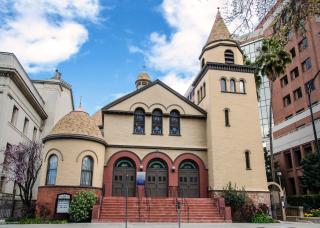Advertisement

© Maxine Goulding
On an October evening in 1995—104 years after builders laid the congregation’s first cornerstone—an Alcoholics Anonymous group meeting inside First Unitarian Church of San José, California, discovered an electrical fire on the roof. Several alarms later, much of the roof had burned, and the water used to extinguish the blaze had damaged significant portions of the building.
What came out of the fire and the multiyear effort to rebuild the church, said senior minister the Rev. Nancy Palmer Jones, includes a labyrinth at the heart of the sanctuary, theater-style seating that replaced decades-old pews, and a space that feels “like you’re getting a hug from the building, in the best way.”
Unitarian services in San José were first held at city hall in 1865. The church’s current site, in the heart of downtown, was purchased in 1888. G.W. Page designed the Richardsonian Romanesque-style building, with its assortment of domes, cupolas, and towers. The church is a California Historical Landmark.
Jones described a “radical inclusivity in the DNA of the congregation” going back to the nineteenth century, which includes a history of openly opposing the internment of people of Japanese descent in the 1940s and of sending leaders to the South during the 1960s. The sanctuary’s design, she said, contributes to that feeling of openness. It is curved, with over a dozen stained glass windows spread out on two stories facing the mahogany pulpit, which, in turn, is almost surrounded by seats. Jones said that the spherical space allows for worship that feels less centered on the person speaking. Some spoken elements of worship services happen from the red-and-gold-traced labyrinth, which rests at the center of the two-story sanctuary.
A predominantly white congregation led by a white minister, First Unitarian hosts the Third Street Community Center, which works largely with families of Latin American descent. Executive Director Rosemary Baez and Jones both describe the summer camp hosted at the church, with dozens of children playing and exploring ideas, as a particularly vibrant time in the building.
“It is comforting knowing I have a vocal church who supports social justice work standing right next to me when I need it most,” Baez said.
As Jones described, “The spiritual history of the church and physical space work together to build this fundamental feeling of turning towards each other.”